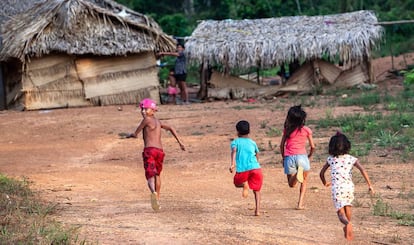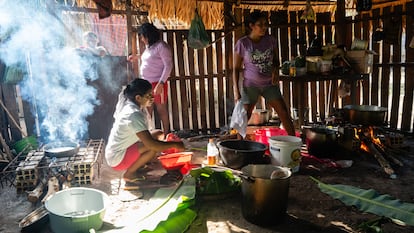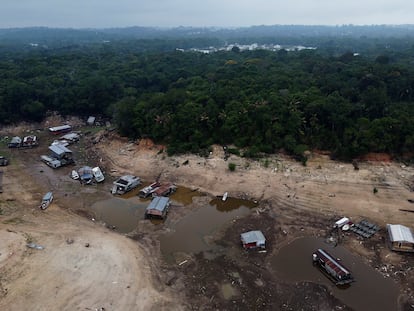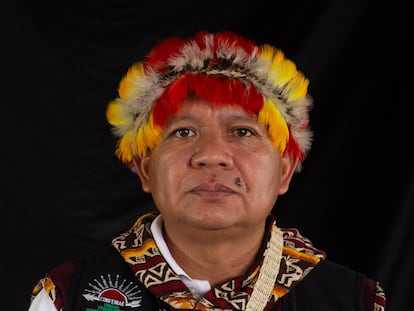Indigenous people of the Amazon reclaim their traditional diet
Processed foods have brought hypertension and diabetes to Brazil’s Arara villages


Children from Arara villages, an Indigenous people in the Brazilian Amazon, now have a school diet that more closely resembles the food their grandparents ate. With the help of a Brazilian NGO called the Socio-Environmental Institute, traditional dishes have been reintroduced to combat the negative impact of processed foods on the people living along the Xingu River, a tributary of the Amazon in northern Brazil. The construction of the Belo Monte hydroelectric dam led to a decline in their traditional diet, resulting in previously unseen health issues like hypertension and diabetes in this corner of the Amazon jungle.
The Arara became infamous for their bellicosity and the trophies they used to capture from the bodies of enemies — heads for flutes, tooth necklaces and more. However, their interaction with the outside world and readiness to welcome strangers had several negative impacts on their way of life. The Socio-Environmental Institute, an NGO that maintains an extensive database of information on Brazil’s Indigenous peoples, is now helping the Arara reclaim their traditional diet. Thought to be extinct in the 1940s, the Arara remained hidden in the forest until their lands were intersected by the Trans-Amazonian Highway in the 1980s, leading to their initial interactions with outsiders. In the 2000s, they received significant compensation for a massive, new hydroelectric dam located in the municipality of Vitoria do Xingu.
For the first time, the Arara tasted cookies, coffee and pasta, as well as salt and sugar. The impact was severe, causing radical dietary changes that quickly turned into health problems. In the last decade, doctors treating the 400 remaining Arara have recorded 45 cases of hypertension and diabetes, diseases previously unknown to them.
Leonardo de Moura, the Social-Environmental Institute’s technical advisor for this project, says the national school meal program is a crucial instrument to combat hunger and improve nutrition in Brazil, but the current design “is inappropriate for Indigenous people.” The school meal program was one of the main gateways for processed food to reach Indigenous villages because it stretches into the most remote corners of the nation. “But to get there without spoiling, the menu usually doesn’t include perishable foods like fruit — nothing green or fresh.”

Since processed foods came to the Arara through the school meal program, it’s now the main mechanism for reversing the trend. For the last several months, kids have been eating new meals at school that include traditional dishes like wàt tynondem (baked fish wrapped in banana leaves), karak’ kuréum (the edible leaves of a non-toxic variety of elephant ear plant), and onatji magarapa (corn cake). These are foods their grandparents used to eat, but that became less popular due to competition from strange, new flavors and eye-catching packaging.
The case of the Arara demonstrates the significant impact caused by a hydroelectric dam that provides 9% of Brazil’s electricity. Belo Monte, a controversial project that ultimately forced Marina Silva to resign as Minister of the Environment in 2008 (a position she now occupies again), continues to be highly contentious because of its ongoing environmental impact.
According to Leonardo de Moura, the Arara people used to use and consume the fruit of eight different types of palm trees. However, because they settled and began to cultivate crops, the current generation of Arara children has lost the knowledge of these palm trees and their various uses. They are also unfamiliar with many of the wild fruits their grandparents consumed daily.
To improve the school diet, the NGO started by asking the younger Arara generation to interview their elders (50-60 years old) about their traditional diet before the Arara came into contact with outsiders. The elders’ responses formed the foundation for developing the new school diet. “It’s traditional knowledge that should be documented immediately,” said De Moura, who laments that, “when we talk about the bioeconomy, we’re usually just talking about gene mapping.” Meanwhile, ancient knowledge is disappearing every time an Indigenous elder dies. “Before, the jungle was like their school. Education is so important, but we must figure out how to make it work in a way that also helps them preserve and strengthen their culture.” De Moura says this project has helped Arara children rediscover wild fruits and palm trees, and learn how to build fish traps.
The idea is to develop and implement a pilot project with the potential for replication in other villages. Rather than sourcing school meal products from the city, the authorities would instead purchase raw ingredients from Indigenous communities and have them prepare the meals. This symbiotic relationship would foster healthier eating habits, generate income for local communities, and safeguard the traditional knowledge that is rapidly fading away.
Sign up for our weekly newsletter to get more English-language news coverage from EL PAÍS USA Edition









































